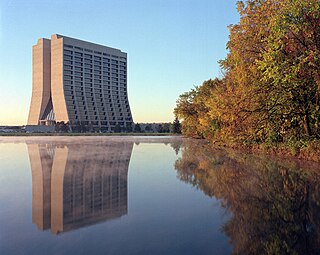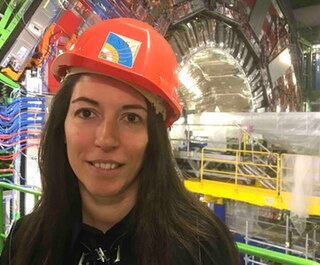
The top quark,sometimes also referred to as the truth quark,is the most massive of all observed elementary particles. It derives its mass from its coupling to the Higgs field. This coupling yt is very close to unity;in the Standard Model of particle physics,it is the largest (strongest) coupling at the scale of the weak interactions and above. The top quark was discovered in 1995 by the CDF and DØexperiments at Fermilab.

The Collider Detector at Fermilab (CDF) experimental collaboration studies high energy particle collisions from the Tevatron,the world's former highest-energy particle accelerator. The goal is to discover the identity and properties of the particles that make up the universe and to understand the forces and interactions between those particles.

The DØexperiment was a worldwide collaboration of scientists conducting research on the fundamental nature of matter. DØwas one of two major experiments located at the Tevatron Collider at Fermilab in Batavia,Illinois. The Tevatron was the world's highest-energy accelerator from 1983 until 2009,when its energy was surpassed by the Large Hadron Collider. The DØexperiment stopped taking data in 2011,when the Tevatron shut down,but data analysis is still ongoing. The DØdetector is preserved in Fermilab's DØAssembly Building as part of a historical exhibit for public tours.

QuarkNet is a long-term,research-based teacher professional development program in the United States jointly funded by the National Science Foundation and the US Department of Energy. Since 1999,QuarkNet has established centers at universities and national laboratories conducting research in particle physics across the United States,and has been bringing such physics to high school classrooms. QuarkNet programs are described in the National Research Council National Science Education Standards report (1995) and support the Next Generation Science Standards (2013).
Arie Bodek is an American experimental particle physicist and the George E. Pake Professor of Physics at the University of Rochester.

Soo-Bong Kim is a South Korean physicist.

Young-Kee Kim is a South Korea-born American physicist and Louis Block Distinguished Service Professor of Physics at the University of Chicago. She is chair of the Department of Physics at the university.

Yaşar Önel is a Turkish-born physicist who holds Swiss and American citizenship. He received his Ph.D. in Physics from London University in 1975. He worked at the Queen Mary University of London in the United Kingdom,and Neuchatel and Geneva Universities in Switzerland before joining the University of Texas at Austin in 1986. Then,he moved to the University of Iowa in 1988. He is a tenured faculty professor. of Physics at the University of Iowa in Iowa City,IA,USA.
Paraskevas Andreas Sphicas is a particle physicist who focuses on studies of High energy collisions in the Large Hadron Collider through which he explores supersymmetry and the mechanism of spontaneous symmetry breaking. He is a senior scientist at CERN and professor of physics at the National and Kapodistrian University of Athens. He was elected a Fellow of the Royal Society (FRS) in 2019.
Olga Evdokimov is a Russian born professor of physics at the University of Illinois,Chicago (UIC). She is a High Energy Nuclear Physicist,who currently collaborates on two international experiments;the Solenoidal Tracker At RHIC (STAR) experiment at the Relativistic Heavy Ion Collider (RHIC),Brookhaven National Laboratory,Upton,New York and the Compact Muon Solenoid (CMS) experiment at the LHC,CERN,Geneva,Switzerland.

Teresa Rodrigo Anoro was a Spanish scientist who worked in particle physics. She worked at CERN,Fermilab and the Instituto de Física de Cantabria and was professor at the University of Cantabria. Whilst at CERN,Rodrigo worked on the Compact Muon Solenoid and research for the Higgs boson.
Sinéad Farrington is a British particle physicist who works on the ATLAS experiment at the Large Hadron Collider.

Kevin T. Pitts is an American high energy particle physicist. In addition to his faculty appointment at the University of Illinois at Urbana–Champaign,in 2021 he was appointed chief research officer at Fermilab National Accelerator Laboratory. His research interests have included the CDF experiment and the Muon g-2 experiment at Fermilab.

Meenakshi Narain was an Indian-born American experimental physicist. She was a Professor of Physics and Chair of the Department of Physics at Brown University,and was also Chair of the Collaboration Board of U.S. institutions in the Compact Muon Solenoid (CMS) Collaboration. She contributed to the discovery of the top quark in 1995 and Higgs Boson in 2012.
Steven Michael Errede is an American experimental physicist,known for his leadership in the collaboration that experimentally confirmed the existence of the top quark.
Carol Elizabeth Anway is a retired American physicist known for her work on computational industrial physics for Boeing,and particularly on lightning protection for airplanes.

Florencia Canelli is since 2021 the appointed Swiss scientific delegate to the CERN council,the supreme decision-making authority of the CERN Organization. From 2021-2024,she was appointed chair of the IUPAP division of particles and field (C11). From 2021-2023,she was co-coordinator of the physics program of the CMS collaboration,a CERN experiment with over 3000 physicists. In 2010,Canelli was awarded the IUPAP Young scientist prize,an international prize awarded to one experimental and one theoretical physicist per year,for "her pioneering contribution to the identification and precision measurements of rare phenomenon through the use of advanced analysis techniques to separate very small signals from large background processes at the Tevatron collider." She has been an author on four multi-purpose collider experiments,namely the CMS experiment and ATLAS experiment at the CERN LHC,and the CDF experiment and D0 experiment at the Fermilab Tevatron. She is currently a full professor at the University of Zurich,Physics Institute,specializing in particle physics.
Freya Blekman is a Dutch professor at the University of Hamburg and the lead scientist at Deutsches Elektronen-Synchrotron (DESY). She contributed to the discovery of the Higgs boson at CERN and has been endowed the Helmholtz Distinguished Professorship. Her individual work specializes in the physics and experimental aspects of elementary particles and fields,specifically looking at the top quark sector by using precision measurements.
Ian P. J. Shipsey FRS was a British experimental particle physicist who led many significant scientific collaborations associated with the CLEO,ATLAS,and CMS experiments,as well as being the head of the physics department at the University of Oxford between 2018 and 2024. He also helped discover the Higgs boson at CERN by development of a pixel detector that was used to detect it.
Christopher Scott Hill is an American particle physicist and Professor of Physics at The Ohio State University. He is known for his contributions to the study of the top quark and for co-founding the milliQan Experiment at the Large Hadron Collider.











